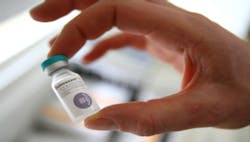How to maintain a trustworthy cold chain during COVID vaccinations
The United States’ COVID-19 vaccine-distribution effort is being challenged at every turn. Some states are reprioritizing who the vaccine gets administered to, while other states lack the necessary volume of vaccines for the Phase 1 initial needs. Given that vaccine-supply decisions are being handled at the federal level and that each state has been required to develop its own strategy, there is great variation to how COVID-19 vaccines are being handled.
Without a standardized approach for executing the delivery of the vaccine to the point of vaccination sites, states are facing a number of logistical challenges, including whether the vaccine about to be injected has remained at the right temperature. The variability in each state’s distribution and access plans are creating confusion and driving a strong need for clarity around each element of the distribution, especially the cold chain. (The cold chain is management of the temperature of perishable products to ensure quality and safety control throughout the distribution process.)
Ensuring the cold chain is not broken is essential for the success of this unprecedented vaccination distribution effort. Everyone—industry professionals and recipients alike – needs reassurance that the proper variable temperature of the vaccine has been sustained throughout its entire distribution journey and that viable doses have not been compromised by heat exposure prior to injection. To make things even more challenging, all approved COVID-19 vaccines and outstanding candidates range in stability profiles from ultra-frozen to frozen to refrigerated.
Industry experts know that temperature excursions could occur during vaccine distribution, but without appropriate visual temperature-monitoring devices, this information is not readily available to the healthcare professional to help minimize the disposal of viable doses. If even a single dose "feels warm" to the touch or someone thinks it was "probably sitting out too long," there is a very good chance the vial is going to be discarded out of an abundance of caution. Those who are extremely risk-averse may even decide to throw out the whole batch, assuming the entire set of vials may have been heat compromised.
Remember, it may or may not be a licensed healthcare practitioner making these decisions. In many places, volunteers who have injection experience are being recruited and trained exclusively to support COVID-19 vaccination efforts. People do not want to inadvertently inject someone with a vaccine that may not be effective because it has been exposed to potentially damaging heat during transport and/or storage.
Many discussions are focused on dissecting the logistical complexity faced by the vaccine transporters and central distribution centers, but what occurs in the last mile should be most concerning. When the vaccine is removed from storage containers and being prepped, confidence that the cold chain was successfully maintained at every touchpoint is critical.
In high-income regions like North America, temperature loggers are generally used to monitor cold-chain pallets and packages; however, vial-level temperature indicators are not required on individual vaccine units like they are in low- and middle- income regions of the world. So, people handling COVID-19 vaccines after those larger initial shipments are broken down, delivered to administration sites, and dispersed for storage or use have no way of knowing for sure if the vaccine has been heat compromised at any point during the journey.
Here is a look at how individuals touching vaccine vials—from production through administration—can determine if heat exposure has occurred before that point in time:
- Utilization of vial-level temperature-monitoring technologies can ensure that any potentially heat-compromised vials are identified prior to administration. This can be accomplished by applying a vial label that changes color based on heat exposure. If the vaccine is not maintained at the appropriate temperature, the color of the vial label will visually show the person administering the vaccination to not use that vial, without needing additional technology or infrastructure. This maintains ease of use, while minimizing wasted doses.
- When a pallet or package-level temperature logger indicates an excursion, someone should be able to break open that larger unit to confirm if all individual units have been affected and should be taken out of distribution, or if it was just the top layer that got too warm because of direct heat exposure during loading and unloading. This is not possible unless every individual vial has a temperature indicator on it.
- As the vaccine is being unloaded at the administration site, teams should be able to confirm if the dry ice and other transport-cooling methods were effective or if replacement doses need to be ordered immediately to avoid prolonged delays in community vaccination.
While optimism that we can put an end to this pandemic through vaccination is strong, it is challenged by the extreme temperature sensitivity and variability of the different vaccine options. If we want to preserve our limited resources and earn the public’s trust in our ability to maintain the COVID-19 vaccine cold chain through to the last mile, then we must commit to putting small, cost-effective vaccine vial monitors on each individual vial at the point of manufacturing.
If the decision is ultimately made to throw away some doses—amounting to financial waste, a duplicated resource burden and delay in achieving mass vaccination—then we can at least be certain that such action was the result of a confirmed heat excursion, not an individual’s “best judgment.”
By Tony Cecchin, vice president and general manager, Zebra Global Supplies, and president of Temptime
